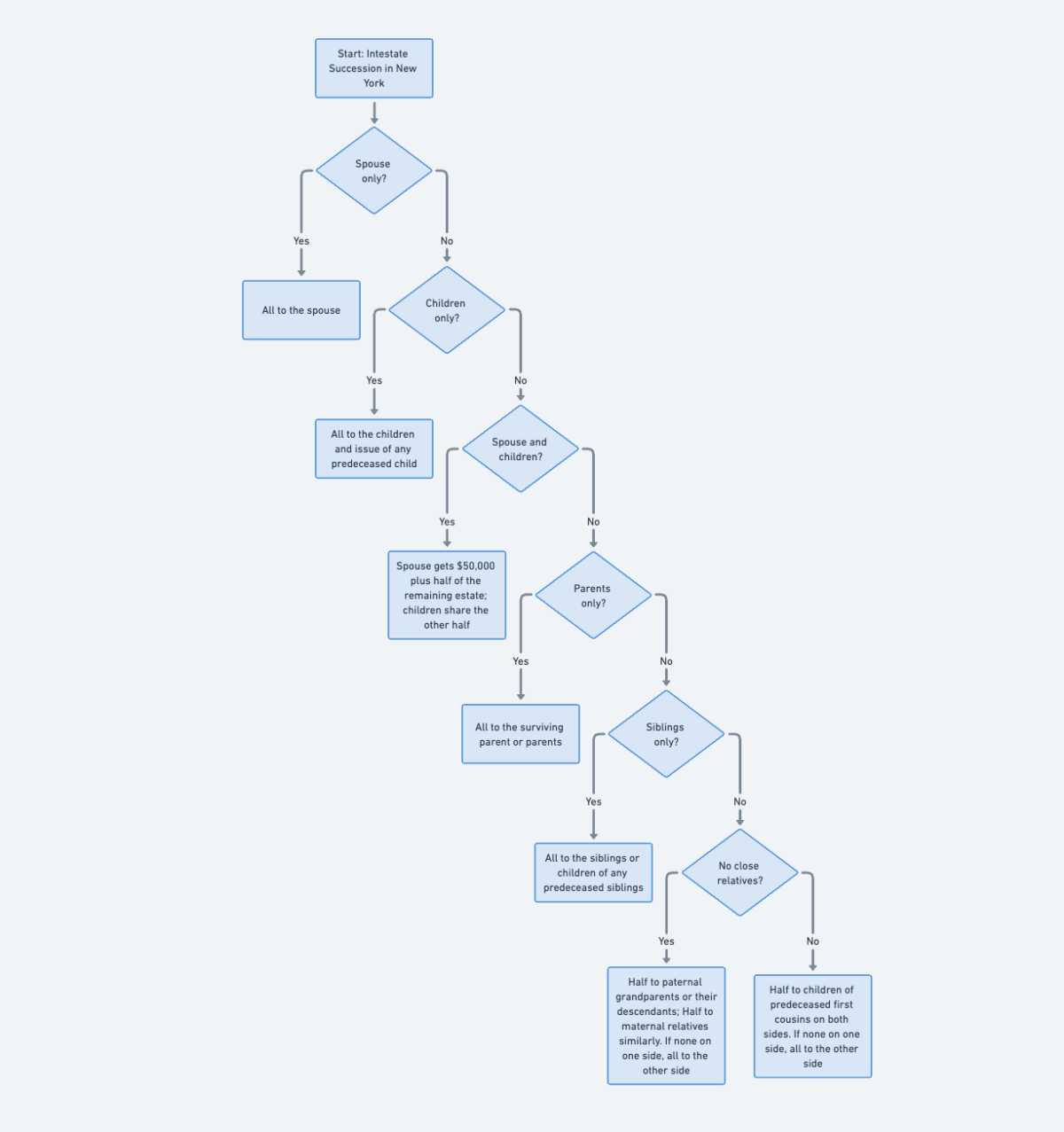Estate Settlement
May 01, 2025
What to Do When Someone Dies in California
Follow this step-by-step guide to navigate legal duties, probate, and estate tasks with clarity and confidence.
Navigating property transfers in NY without a will? Our guide offers clarity, essential steps, and expert insights for a smooth process.


Before transferring property, it's essential to pinpoint all heirs and establish their relationship to the deceased.
As an administrator, it's crucial to understand the distribution hierarchy to ensure assets are distributed accurately. For instance, in cases where only children survive, they'll equally inherit the property. However, if a spouse survives, they'll often inherit a more substantial portion of the property, regardless of the number of living children.
The intestate transfer of property follows a specific legal procedure:
Above is just the overview of the process, let's get into the details of real property transfer without a will in New York.
Following - N.Y. Real Prop. Law § 423, here is how you transfer property if the deceased passed away without a will in New York:
Petitioning for Transfer:
A pivotal first step in this process is the initiation of a 'verified petition and order.' But what does this entail?
A Verified Petition and Order: In essence, this is a formal request submitted to the registrar of the county where the original property registration occurred. In certain situations, the administrator or personal representative may be asked to include a verified copy of the death certificate of the deceased.
Detailing the desire and reasons to transfer the title of a property. It must be verified, meaning that it must be confirmed as true and accurate, providing assurance that the claims made in the petition are legitimate.
Obtaining the Petition: To instigate the transfer process, the heirs-at-law — the recognized successors when no will is present — must acquire this petition. This petition's essential components include the names and known places of residence of the petitioner and all those claiming any interest in the property, either through a certificate of title, a registered instrument, or by law.
If the surviving spouse or joint tenant with rights of survivorship is petition for the transfer of property ownership, the registrar may make this form under N.Y. Real Prop. Law § 423-A available.
File the petition where the decedent domiciled.Even if the decedent passed away in a nursing home, file the petition in the county where the deceased use to reside, even if they no longer own that property.
Getting Consents and Signatures:
No petition moves forward without the green light from a few key entities.
Registrar's Approval: The registrar, a critical figure in property title transfers, must provide consent. Upon obtaining a properly filled-out petition, the registrar will play an instrumental role, including memorializing the petition and eventually issuing the new certificate of title.
State Attorney General's Consent: In New York, the consent of the state attorney general is indispensable. This ensures an additional layer of verification, aligning the transfer with state interests and regulations.
Signature from a Justice of the Supreme Court: Last, but certainly not least, is the approval from the judiciary. A justice of the supreme court must sign the verified petition and order. This judicial endorsement ensures that the transfer is in accordance with the state's legal standards.
Providing Sufficient Evidence:
It's not just about filing papers. It's about proving the legitimacy of the claims within them.
'Sufficient and Conclusive' Evidence: The law doesn't merely require evidence; it demands evidence that is both ample and definitive. This means the proof provided must be robust, leaving no room for doubt regarding the heirs-at-law and their rightful claim to the property.
Identifying All Heirs-at-law: To ensure a smooth process, it's pivotal to clearly identify all legitimate heirs. This step safeguards against future disputes and ensures all parties with a rightful claim are accounted for.
Property Distribution in New York According to The Laws of Intestacy:
Intestacy might sound like a complicated term, but its essence is quite straightforward.
Definition of Intestate: When someone dies 'intestate', they have passed away without leaving a valid will. In such scenarios, the state's intestacy laws take precedence in determining property distribution.
New York's Intestacy Laws: In the absence of a will, New York's laws lay out a clear hierarchy of successors.
This sequence starts with the spouse and descendants and then moves to other relatives if the former are nonexistent. The state ensures that property gets distributed in a manner that reflects potential wishes of the deceased, as deduced from familial ties.
For illustration, we've created a flow chart to help you gain a visual understanding of how assets, pass along according to the intestate succession laws in New York:

Navigating the process of transferring a property title, especially posthumously, can be a complex journey riddled with potential challenges. It's crucial to anticipate these hurdles and be equipped to handle them efficiently. Here's an exploration of some common pitfalls and how they can influence the title transfer process:
The Issue: When a property owner passes away intestate (without a will), determining the rightful heirs can be ambiguous. This ambiguity can lead to conflicts among potential heirs, each claiming a stake in the property.
The Implication: Such disputes can delay the title transfer process and, in some instances, may lead to legal battles. This not only prolongs the process but can also escalate the emotional and financial strain on all parties involved.
The Issue: As stipulated in the N.Y. Real Prop. Law § 423, multiple consents and signatures are requisite, including from the registrar, state attorney general, and a justice of the supreme court. Obtaining these approvals can be time-consuming.
The Implication: Delayed approvals can push back the title transfer timeline. Moreover, any inconsistencies or inaccuracies in the documentation can result in these authorities withholding their consent, causing further delays.
The Issue: The title transfer process is heavily reliant on precise documentation. From the "petition on the annexed form" to evidence proving the heirs-at-law, each document must be accurate, complete, and in alignment with New York's legal standards.
The Implication: Incomplete or inaccurate documentation can lead to a rejection or resubmission of the petition, adding more time to the transfer process. Moreover, discrepancies in documentation can open the door to legal challenges, further complicating the situation.
In the world of real property and its legal intricacies, the registrar stands as a pivotal figure, especially when it comes to transferring property titles in New York. Delving into the nuances of N.Y. Real Prop. Law § 423 sheds light on the crucial responsibilities shouldered by the registrar in this process.
Responsibilities of the Registrar:
Petition Review: The initial step involves the heirs-at-law or the executor/administrator presenting the "petition on the annexed form" to the registrar. The registrar's duty is to review this petition, ensuring its accuracy, completeness, and alignment with the state's legal requirements.
Memorializing the Petition: Once approved, the registrar then memorializes the petition. This process involves formally recording and acknowledging the change in ownership within the official records, providing a traceable and legal chronicle of the transfer.
Deleting Previous Ownership Details: The registrar is responsible for removing or "deleting" the name of the deceased owner from the official county clerk records, which signifies the end of their legal ownership of the property.
Recertifying and Issuing New Certificates of Title: As the final and perhaps most significant step, the registrar recertifies the title to reflect the new owner. This entails the issuance of a new certificate of title as directed by the order, signifying the formal and legal recognition of the new property owner.
Issuance of a New Certificate of Title:
The new certificate of title is not merely a document but a powerful symbol of ownership and rights. When the registrar issues this certificate, it's done based on the directives of the verified petition and order and signifies a seamless transfer of ownership rights from the deceased to the new owner.
The new owner must file form: RP-5217-PDF to the county clerk to complete the real property transfer.
It's an affirmation that the new owner now holds all the rights, responsibilities, and privileges associated with the property, backed by the state's legal framework.
When filing the petition for probate, the administrator is subject to pay a tiered scheduled fee (re-imbursable by the estate).
As outlined by the NY surrogate court, Under: Article 24 Court Fees §2402. - the fees are as follows:
| Value Of The Estate | Fee |
|---|---|
| Less than $10,000 | $45.00 |
| $10,000 but under $20,000 | $75.00 |
| $20,000 but under $50,000 | $215.00 |
| $50,000 but under $100,000 | $280.00 |
| $100,000 but under $250,000 | $420.00 |
| $250,000 but under $500,000 | $625.00 |
| $500,000 and over | $1,250.00 |
And then, the filing fee for Form RP-5217-PDF is $125 for residential and farm properties, while "other" properties are subject to a $250 filing fee.
Property transfers, especially after a loved one's passing, require a thoughtful approach and expert advice. Every individual case holds its unique intricacies, and you shouldn't have to wade through them alone. We're offering a FREE consultation to help clarify your doubts and ensure a smooth transition.
Make informed decisions with confidence. Rely on our expertise, and together, we'll streamline the journey.
Book your free consultation now for a hassle-free property transfer experience.
 Simplify Probate Today
Simplify Probate Today
Get expert guidance from our specialists who've helped 10,000+ families.
Book a free consultation